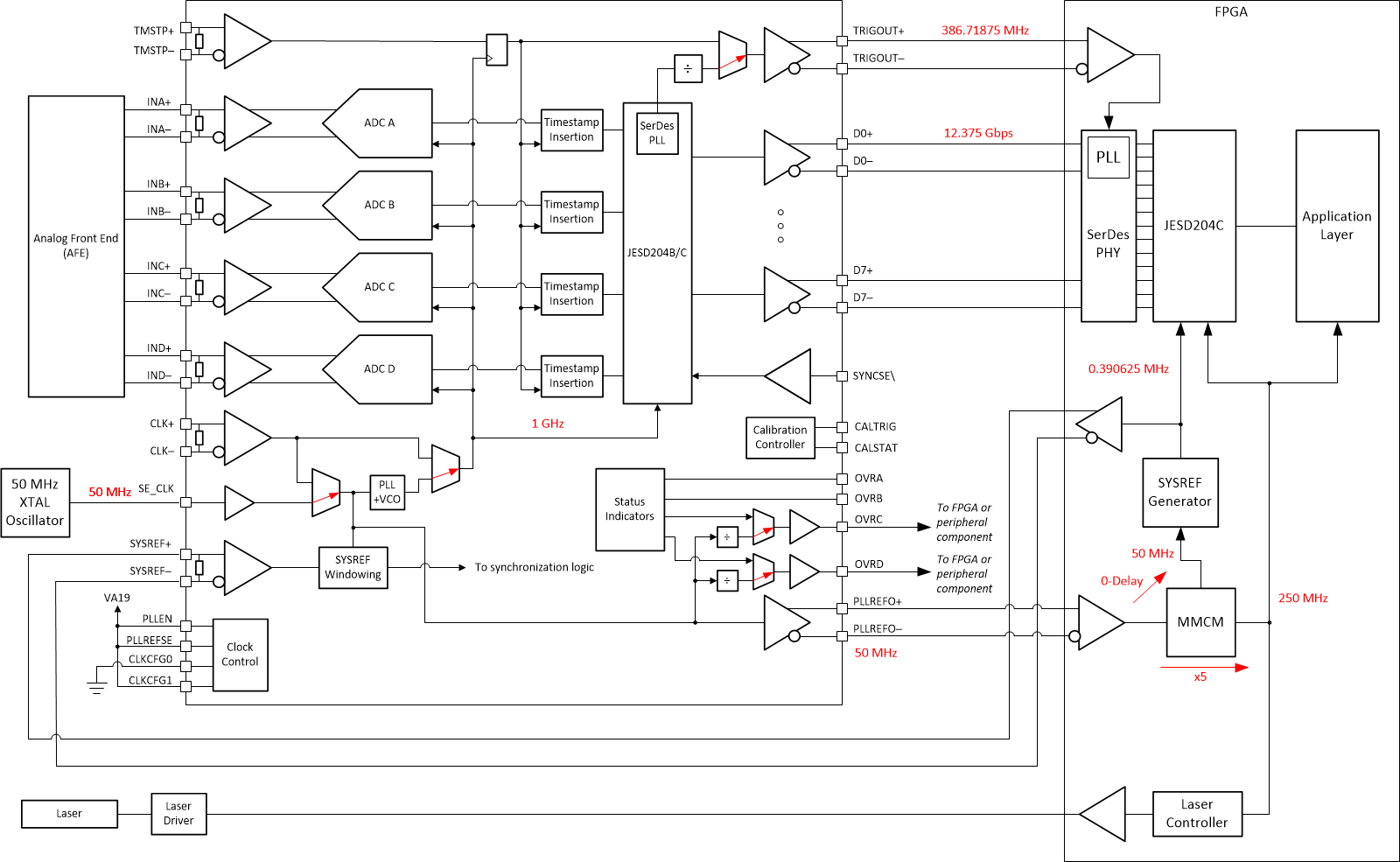SBAS997B February 2020 – October 2024 ADC09DJ1300-Q1 , ADC09QJ1300-Q1 , ADC09SJ1300-Q1
PRODUCTION DATA
- 1
- 1 Features
- 2 Applications
- 3 Description
- 4 Pin Configuration and Functions
-
5 Specifications
- 5.1 Absolute Maximum Ratings
- 5.2 ESD Ratings
- 5.3 Recommended Operating Conditions
- 5.4 Thermal Information
- 5.5 Electrical Characteristics: DC Specifications
- 5.6 Electrical Characteristics: Power Consumption
- 5.7 Electrical Characteristics: AC Specifications
- 5.8 Timing Requirements
- 5.9 Switching Characteristics
- 5.10 Typical Characteristics
-
6 Detailed Description
- 6.1 Overview
- 6.2 Functional Block Diagram
- 6.3
Feature Description
- 6.3.1 Device Comparison
- 6.3.2
Analog Input
- 6.3.2.1 Analog Input Protection
- 6.3.2.2 Full-Scale Voltage (VFS) Adjustment
- 6.3.2.3 Analog Input Offset Adjust
- 6.3.2.4 ADC Core
- 6.3.2.5 Temperature Monitoring Diode
- 6.3.2.6 Timestamp
- 6.3.2.7 Clocking
- 6.3.2.8
JESD204C Interface
- 6.3.2.8.1 Transport Layer
- 6.3.2.8.2 Scrambler
- 6.3.2.8.3 Link Layer
- 6.3.2.8.4 8B/10B Link Layer
- 6.3.2.8.5 64B/66B Link Layer
- 6.3.2.8.6 Physical Layer
- 6.3.2.8.7 JESD204C Enable
- 6.3.2.8.8 Multi-Device Synchronization and Deterministic Latency
- 6.3.2.8.9 Operation in Subclass 0 Systems
- 6.3.2.8.10 Alarm Monitoring
- 6.4
Device Functional Modes
- 6.4.1 Low Power Mode and High Performance Mode
- 6.4.2 JESD204C Modes
- 6.4.3 Power-Down Modes
- 6.4.4
Test Modes
- 6.4.4.1 Serializer Test-Mode Details
- 6.4.4.2 PRBS Test Modes
- 6.4.4.3 Clock Pattern Mode
- 6.4.4.4 Ramp Test Mode
- 6.4.4.5 Short and Long Transport Test Mode
- 6.4.4.6 D21.5 Test Mode
- 6.4.4.7 K28.5 Test Mode
- 6.4.4.8 Repeated ILA Test Mode
- 6.4.4.9 Modified RPAT Test Mode
- 6.4.4.10 Calibration Modes and Trimming
- 6.4.4.11 Offset Calibration
- 6.4.4.12 Trimming
- 6.5 Programming
- 6.6 SPI_Register_Map Registers
- 7 Application and Implementation
- 8 Device and Documentation Support
- 9 Revision History
- 10Mechanical, Packaging, and Orderable Information
Package Options
Mechanical Data (Package|Pins)
- AAV|144
Thermal pad, mechanical data (Package|Pins)
Orderable Information
7.2.1 Light Detection and Ranging (LiDAR) Digitizer
A LiDAR system uses a laser to send a light pulse toward a target and measures reflections off of the target using photodiodes. The photodiodes are connected to transimpedance amplifiers (TIA) to convert the current generated by the reflected light into a voltage. An ADC converts the voltage to a digital signal and extracts the pulse arrival time and reflected energy of the pulse. The device has a number of features that makes it ideal as the digitizer for a LiDAR system including high sampling rate, high performance, high input bandwidth and integrated clocking features. An example LiDAR system digitizer is shown in Figure 7-1 which uses up to four ADC channels running at 1 GSPS and the on-chip clocking features of the device to reduce the component count, size and cost of the system.
 Figure 7-1 Typical
Configuration for a LiDAR Digitizer
Figure 7-1 Typical
Configuration for a LiDAR Digitizer